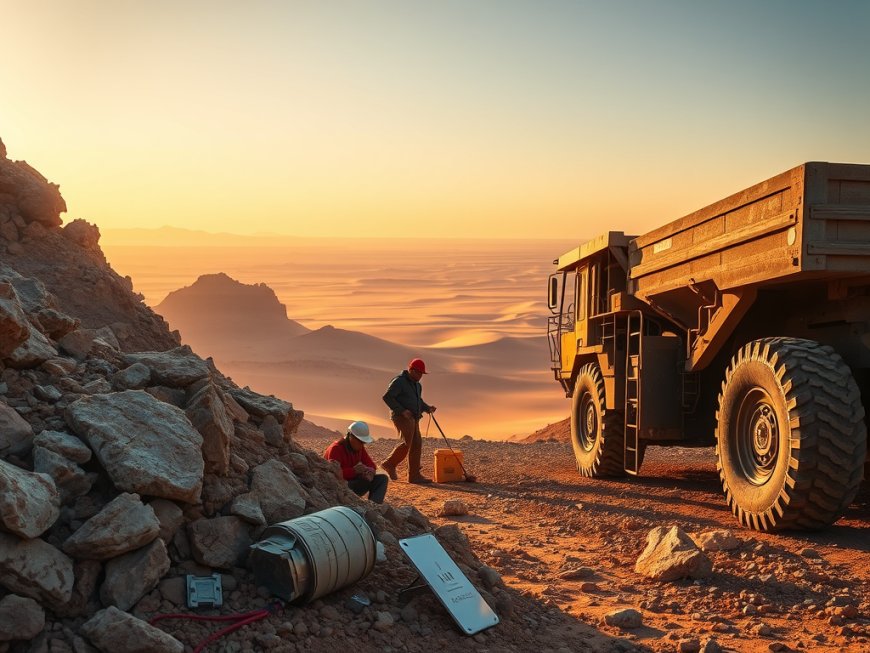Morocco's Push for EV Batteries: Lithium and Beyond in the Sahara
Morocco's ONHYM has partnered with LARC Morocco SAS to explore lithium and gold in the Sahara, enhancing its mineral resource exploitation. This initiative aligns with Morocco's energy transition strategy and aims to boost its position in the global electric vehicle battery market. The country seeks to attract investments and strengthen its renewable energy leadership.

In a significant move to bolster its strategic metal reserves and enhance industrial sovereignty, Morocco's National Office of Hydrocarbons and Mining (ONHYM) has entered into a partnership with LARC Morocco SAS, a subsidiary of Lithium Africa Resources Corp. This collaboration marks the beginning of a new chapter in Morocco's exploitation of its natural resources, particularly in the Sahara region.
Details of the Agreement
The agreement, signed by Amina Benkhadra, Director General of ONHYM, and Carl Esprey, CEO of LARC Morocco, aims to explore the potential for lithium and gold in the Bir El Mami area of the Dakhla-Oued Ed-Dahab region. Here are the key details of the agreement:
- Partners Involved: The partnership is between ONHYM and LARC Morocco SAS.
- Location: The exploration will take place in the Bir El Mami area within the Dakhla-Oued Ed-Dahab region.
- Objectives: The primary goal is to advance Morocco's strategy for promoting strategic metals essential for the energy transition and the country's industrial sovereignty[1].
The Significance of Lithium
Lithium is a crucial element in the manufacturing of batteries for electric vehicles (EVs), a sector that is gaining immense importance globally as the world transitions towards cleaner energy. Morocco's move to explore lithium deposits aligns with its broader strategy to capitalize on its mineral resources to meet the growing global demand for EV batteries.
Broader Context
This initiative is part of Morocco's larger effort to strengthen its position as a leader in renewable energy and green mobility. The country is already a significant player in the automotive industry, with major manufacturers like Stellantis and Renault operating production plants within its borders.
Automotive Sector Growth
Morocco's automotive sector is one of its top industrial exports, with a value of $14 billion in 2023, representing a 27% increase. The sector boasts production plants with a combined annual capacity of 700,000 vehicles. By 2030, Morocco aims to increase this output to 1 million vehicles per year, with a significant portion expected to be electric vehicles[2].
Attracting EV Battery Manufacturers
The Moroccan government is actively seeking to attract more electric battery manufacturers. Recent agreements include the approval for Chinese electric battery maker BTR New Material Group to build a factory near Tangier and another by CNGR Advanced Material to build a cathode plant in Jorf Lasfar. These investments are part of Morocco's plan to establish itself as a hub for EV battery production, leveraging its strategic location and favorable economic conditions[2].
Reactions and Implications
- Government Officials: Moroccan officials have expressed optimism about the agreement, emphasizing its potential to contribute to economic development.
- Observers: Analysts see this move as a potential magnet for foreign investment and a step towards solidifying Morocco's position as a regional hub for renewable energy.
Other Key Developments in Morocco's Energy Transition
Domestic Lithium Deposits
Moroccan media have reported the discovery of significant lithium deposits in the country's Sahara region near the Mauritanian border. This domestic supply could be crucial for Morocco's ambitions in the EV battery sector[3].
Phosphate Reserves
Morocco's vast phosphate reserves are another critical factor in its transformation into a global EV battery production hub. The country is the world's second-largest phosphate producer, after China, and its phosphate reserves are being leveraged to produce lithium iron phosphate (LFP) batteries, which are safer and less expensive than cobalt-based batteries[3].
International Partnerships
Morocco's strategic location and free trade agreements with the European Union and the United States make it an attractive location for international partnerships. For instance, LG Energy Solution (LGES) has signed an agreement to procure lithium from a Moroccan producer, and South Korea’s LG Chem and China’s Youshan are partnering to build an LFP cathode plant in Morocco, scheduled to come online by 2026[4][5].
Table: Key Projects and Partnerships
Project
Location
Partners
Expected Outcome
Lithium and Gold Exploration
Bir El Mami, Dakhla-Oued Ed-Dahab
ONHYM, LARC Morocco SAS
Exploration and potential extraction of lithium and gold
BTR New Material Group Factory
Near Tangier
BTR New Material Group
Production of cathodes for EV batteries
CNGR Advanced Material Plant
Jorf Lasfar
CNGR Advanced Material
Production of cathodes for EV batteries
LGES Lithium Procurement
Morocco
LGES, Yahua Industrial Group
Stable supply of lithium hydroxide for EV battery production
LG Chem and Youshan LFP Cathode Plant
Morocco
LG Chem, Youshan
Production of up to 50,000 metric tons of LFP cathodes by 2026
Conclusion
Morocco's decision to explore lithium in the Sahara region marks a significant milestone in its journey towards a more sustainable and industrialized future. With its rich mineral resources, strategic partnerships, and favorable economic conditions, Morocco is poised to become a key player in the global EV battery market. This move not only aligns with Morocco's energy transition goals but also positions the country as a critical hub in the global supply chain of critical minerals.
As Morocco continues to attract investments and forge international partnerships, it is clear that the country is on the path to a greener and more economically robust future. The upcoming years will witness significant developments in Morocco's energy sector, further solidifying its status as a leader in renewable energy and green mobility.

